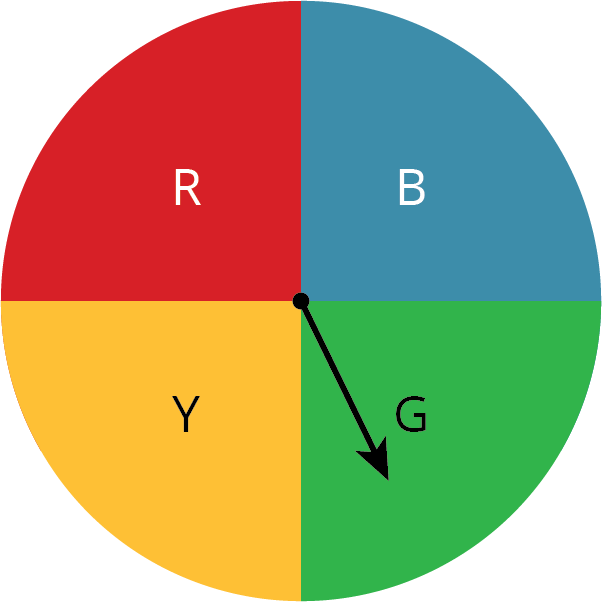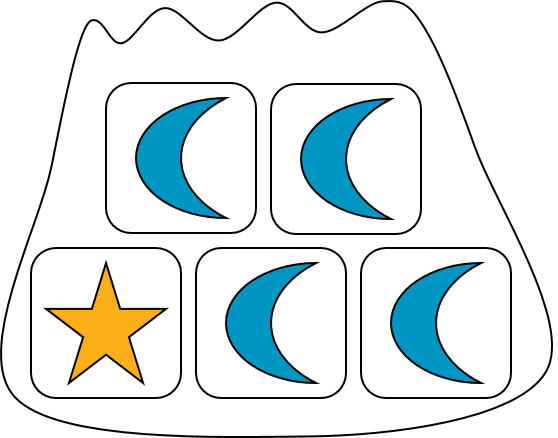Lesson 3
What Are Probabilities?
Let’s find out what's possible.
3.1: Which Game Would You Choose?
Which game would you choose to play? Explain your reasoning.
Game 1: You flip a coin and win if it lands showing heads.
Game 2: You roll a standard number cube and win if it lands showing a number that is divisible by 3.
3.2: What’s Possible?
-
For each situation, list the sample space and tell how many outcomes there are.
- Han rolls a standard number cube once.
-
Clare spins this spinner once.

- Kiran selects a letter at random from the word “MATH.”
- Mai selects a letter at random from the alphabet.
- Noah picks a card at random from a stack that has cards numbered 5 through 20.
-
Next, compare the likelihood of these outcomes. Be prepared to explain your reasoning.
- Is Clare more likely to have the spinner stop on the red or blue section?
- Is Kiran or Mai more likely to get the letter T?
- Is Han or Noah more likely to get a number that is greater than 5?
- Suppose you have a spinner that is evenly divided showing all the days of the week. You also have a bag of papers that list the months of the year. Are you more likely to spin the current day of the week or pull out the paper with the current month?
Are there any outcomes for two people in this activity that have the same likelihood? Explain or show your reasoning.
3.3: What’s in the Bag?
Your teacher will give your group a bag of paper slips with something printed on them. Repeat these steps until everyone in your group has had a turn.
- As a group, guess what is printed on the papers in the bag and record your guess in the table.
- Without looking in the bag, one person takes out one of the papers and shows it to the group.
- Everyone in the group records what is printed on the paper.
- The person who took out the paper puts it back into the bag, shakes the bag to mix up the papers, and passes the bag to the next person in the group.
| Guess the sample space. |
What is printed on the paper? |
|
|---|---|---|
| person 1 | ||
| person 2 | ||
| person 3 | ||
| person 4 |
- How was guessing the sample space the fourth time different from the first?
- What could you do to get a better guess of the sample space?
- Look at all the papers in the bag. Were any of your guesses correct?
- Are all of the possible outcomes equally likely? Explain.
- Use the sample space to determine the probability that a fifth person would get the same outcome as person 1.
Summary
The probability of an event is a measure of the likelihood that the event will occur. Probabilities are expressed using numbers from 0 to 1.
- If the probability is 0, that means the event is impossible. For example, when you flip a coin, the probability that it will turn into a bottle of ketchup is 0. The closer the probability of some event is to 0, the less likely it is.
- If the probability is 1, that means the event is certain. For example, when you flip a coin, the probability that it will land somewhere is 1. The closer the probability of some event is to 1, the more likely it is.
If we list all of the possible outcomes for a chance experiment, we get the sample space for that experiment. For example, the sample space for rolling a standard number cube includes six outcomes: 1, 2, 3, 4, 5, and 6. The probability that the number cube will land showing the number 4 is \(\frac16\). In general, if all outcomes in an experiment are equally likely and there are \(n\) possible outcomes, then the probability of a single outcome is \(\frac{1}{n}\).
Sometimes we have a set of possible outcomes and we want one of them to be selected at random. That means that we want to select an outcome in a way that each of the outcomes is equally likely. For example, if two people both want to read the same book, we could flip a coin to see who gets to read the book first.
Glossary Entries
- chance experiment
A chance experiment is something you can do over and over again, and you don’t know what will happen each time.
For example, each time you spin the spinner, it could land on red, yellow, blue, or green.

- event
An event is a set of one or more outcomes in a chance experiment. For example, if we roll a number cube, there are six possible outcomes.

Examples of events are “rolling a number less than 3,” “rolling an even number,” or “rolling a 5.”
- outcome
An outcome of a chance experiment is one of the things that can happen when you do the experiment. For example, the possible outcomes of tossing a coin are heads and tails.
- probability
The probability of an event is a number that tells how likely it is to happen. A probability of 1 means the event will always happen. A probability of 0 means the event will never happen.
For example, the probability of selecting a moon block at random from this bag is \(\frac45\).

- random
Outcomes of a chance experiment are random if they are all equally likely to happen.
- sample space
The sample space is the list of every possible outcome for a chance experiment.
For example, the sample space for tossing two coins is:
heads-heads tails-heads heads-tails tails-tails